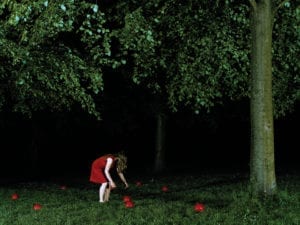Ironically, it is the ubiquity of computers and technology in our lives that makes the art that exploits them so arcane, with its proximity to the surface often belying its depth. Through a collection of works arranged counter-chronologically from the present to the advent of technologically integrated art 50 years ago, the Whitechapel Gallery’s Electronic Superhighway provides detailed and fascinating insights into an area of art whose relevance seems to increase with the quickness of Moore’s Law.
The gallery’s ground floor deals with pieces created between 2000 and 2016 and, as a pertinent reflection of the technology the works embody – where ideas and perspectives proliferate and are conflated with phenomenal speed – their contents jump between and intersect media and subject matter with millennial hyperactivity. The range of subjects is enormous, touching often with humour upon aesthetics, experience, narrative, queer theory, gender, sex, conflict, and surveillance. Oliver Laric’s Versions (Missile Variations) (2010), for instance, explores online authenticity and representation through airbrushed paintings based on Photoshopped images of an already notoriously Photoshopped Iranian nuclear test. Nearby, with its own kind of humour but also a theory-laden seriousness, pieces from Zach Blas’ art group Queer Technologies are presented as technological consumer products proposing solutions to oppression, often subverting the existing or past technologies whose function it originally was to oppress.
The upstairs rooms look more at the original projects that laid the way for computer based art. Here works such as Nam June Paik’s Internet dream (1994), one of his famous “videowalls” – or stacks of television monitors displaying various configurations of footage – share space with more solidly expository pieces. In the same room, Rafael Lozano-Hemmer’s Surface Tension (1992) uses custom made software to project an eye which genuinely does follow a viewer round the room (though with a jerkiness reflecting its time). Also upstairs are some of the earliest artworks incorporating computer guided and generated drawing by artists such as Frieder Nake, Ulla Wiggen, Vera Molnar, and Hiroshi Kiwano. Adding context, these computer influenced drawings and an abundance of video pieces are accompanied by historical and documentary material providing insights into how technology and art came together, such as Cybernetic Serendipity, a landmark 1968 exhibition on art and technology at the ICA, and E.A.T (Experiments in Art and Technology), an organisation formed in 1967.
Across the exhibition as a whole, some pieces are traditional in conception but utilise contemporary methods. Jon Rafman’s New Age Demanded (Elegant Rock Virus) (2014), for instance, is essentially modernist in its form, but is realised using 3D photopolymer printing and a deep blue powder pigment evoking Yves Klein. Likewise, Jan Robert Leegte’s Scrollbar Composition (2000), a webpage consisting of HTML/CSS boxes and constantly moving scrollbars, appears at a glance to follow the golden ratio employed by painters from Da Vinci to Dalì. That said, many works here treat the Internet and technology as sources of both form and content. Among them is a print from Amalia Ulman’s groundbreaking Instagram project Excellences & Perfections (2015), a sharply executed narrative performance piece in which Ulman, through an Instagram persona, delves unflinchingly into the construction of womanhood on and offline.
Electronic Superhighway is a large, complex, and fascinating exhibition. Both informative and entertaining, its lasting impression is of the democratic, egalitarian, and yet anarchic nature of the Internet. Given that traditional processes, forms of artistic labour, and the significance of gallery space have different meanings where much of the art can be presented digitally, new modes of expression and experience between artist and viewer necessarily open up. A poignant example can be found in one of the smaller pieces on display, and yet one of the most moving. Olia Lialina’s My Boyfriend Came Back from the War (1996) is a simple webpage with a series of HTML windows containing text and low-resolution monochrome images. On clicking an image or text the boxes subdivide until all that is left is a grid of empty black frames, advancing a fragmented narrative of trauma and loss. Acutely personal, the effect is like delving into the rabbit hole of a damaged psyche or disintegrating relationship; the simultaneous isolation and claustrophobia are palpable. Adding a further layer to the work, though not mentioned at the exhibit, since 1996 a series of ‘remixes’ have been created, adjusting its themes and media.
That so much can be done with so little and then proliferate online, and that representations may have an equal platform to originals, contributes to the overall impression of Electronic Superhighway: with ever-increasing speed we alternate between subject and object, representation and self-representation, viewer and viewed. Ultimately the technology we make can also make us.
Ned Carter Miles
Electronic Superhighway (2016-1966); until 15 May, Whitechapel Gallery, 77-82 Whitechapel High St, London E1 7QX.
Explore the exhibition at www.whitechapelgallery.org.
Follow us on Twitter @AestheticaMag for the latest news in contemporary art and culture.
Credits
1. Addie Wagenknecht, Asymmetric Love, 2013. Courtesy of Whitechapel Gallery.





